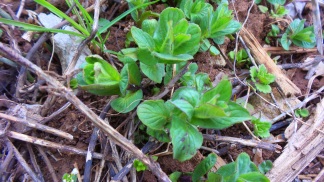post 198/365

The joy of wild food is about discovery, Harvesting wild food is the oldest and most basic subsistence activity of humankind, but today we live in a world where these skills are almost lost. Foraging is the missing link in modern civilized cultures–it is this direct physical connection, in the form of sustenance that brings us to our deepest appreciation and understanding of the natural world.
Wild edible plants and herbs grow widely in all Lebanese territories from mountains to valleys. They are there within hands reach what you will be able to amass is wonders of things that are part of our daily cuisine. Za’atar, wild asparagus from the South that grows on the sides of rivers, hindbeh (dandelion), mushrooms, a’koub (gundelia), shumar (fennel), iklil el jabal (rosemary), akkedenia (loqat), heshé wmeshé, khebayze, and so much more
There is a beauty and art in creating an amazing whole hearty dish from simple honest ingredients that are humble and unappreciated. A lot of our cuisine is made of greens and herbs that were foraged by our ancestors and turned into beautiful dishes with depth of flavor and tastes. Having gone through several famines in their times, our ancestors have learned to use what the earth has so graciously given them and create dishes that have made our cuisine so popular ever since.
A’koub, a thorn that grows in the high mountains of Lebanon This thorn is notoriously difficult and painful to harvest and its preparation is equally hazardous. But what you are left with, apart from green-hued bleeding fingers is a stem that works culinary wonders in stews, stir-fries and with eggs. It can only be hunger that drive someone to go through the process of finding its inner beauty.
Another such example of unlikely food is the dandelion, widely loved in Lebanon and is the main ingredient and namesake of the popular dish hindbeh. Dandelions might be commercially grown in Lebanon, but most families buy it from the forager. The smooth dandelion leaf is best harvested in early spring if intended to be eaten raw in salads, as its bitter flavor has not fully developed. As the leaf matures, it grows larger, thicker and bitterer. However, bitterness is not a bad thing, as it is usually an indicator of a plant’s ability to detoxify the body and the liver (or that the plant is poisonous). Dandelions are high in protein, naturally diuretic and anti-inflammatory and are rich in potassium and beta-carotene and many other highly beneficial minerals, which is why this humble plant has been very popular in herbal medicine.
My love for Hindbeh has no limits, the subtle taste of bitterness from the dandelion with the earthy combination of sautéed garlic and olive oil, an unexpected sweetness that lingers from the trail of caramelized onions, all washed up by the hint of lemon juice squeezed on top of it makes it an alluring humble dish to savor.
While our children are picking the dandelion flowers and making a wish before blowing on the parachute-like seeds, remind them that this wild dandelion that grows in the sun and dances to the beat of the wind, scattering seeds of peace and songs of love, has so much more magic to it then meets their little fingers.
Recipe of Hindbe:
2 bunches of dandelion
2 big onions
1 cup of Olive oil
1 clove of garlic, finely chopped
1 cup of fresh chopped cilantro
Juice of a big lemon
Salt and pepper.
Chop the 2 bunches of dandelion, clean very well by soaking them in water and some salt and then wash and drain. Add dandelion into a big pot of boiling water and let them cook until they’re done, just like spinach. Drain them very well also like spinach then roughly chop them again. Slice the 2 big onions by cutting them into halves then slicing each half, sort of like obtaining medium thin half circles.
In a skillet, add olive oil, then the onions (leave about a handful aside). Now the onions need to cook until they become dark brown but not burned. When they’re done, take them out of the skillet to a side plate, then in the same remaining oil add the the uncooked onions, cook them until golden then add the garlic, then the cilantro, cook for about one minute then add the dandelion, salt and pepper. Mix them all together and cook for about 10 minutes then add the lemon juice. If you feel that the dandelions absorbed all the olive oil while cooking, then you might wanna add another tablespoon.
Some of those pictures are taken from: http://lebanonuntravelled.com/foraging-in-lebanese-mountains/













It might be interesting to note that the word dandelion originates from the French word “dent de lion” meaning tooth of the lion. A simple and savory dish indeed. Feels like you can never have enough of it.
LikeLike
Hello Ziad, thank you for that. it is. i will add it tonight.
LikeLike